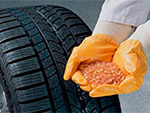Specialists from the National Research Center "Kurchatov Institute" together with colleagues from the Institute of Synthetic Polymer Materials and the Institute of Organoelement Compounds of the Russian Academy of Sciences have developed a technology that improves the quality of rubber obtained from organosilicon rubber. It allowed not only to turn rubber into rubber, but also to significantly improve the mechanical properties of the resulting materials.
Rubbers obtained from organosilicon rubber for use in composite materials are more heat- and weather-resistant than traditional ones, resistant to ozone and ultraviolet radiation. However, the silicon dioxide particles used in their manufacture actively interact with each other and stick together, forming so-called "lumps" of different sizes. Because of this, the structure of the rubber becomes heterogeneous, which reduces its strength.
Instead, scientists have proposed using so-called MQ resins as a filler - compounds in which a rigid core based on silicon dioxide is surrounded by flexible chains of silicon, oxygen and methyl that prevent the nuclei from sticking together.
The conducted tests have shown that the obtained materials recover quickly after the removal of the mechanical load. This makes them in demand in areas where it is necessary to withstand frequent stretching and compression.
The results of the study are published in the National Library of Medicine.

